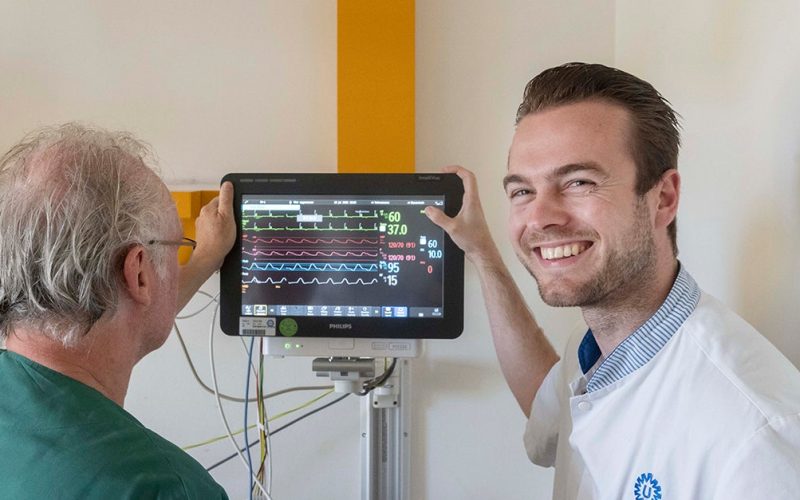Rhythm nurses have been able to monitor patients even better since Tuesday, July 12. This offers the chance to intervene earlier when someone’s situation worsens. This progress is due in part to the eight bedside monitoring monitors put into use within the advanced heart failure unit. These concern patients in whom the heart’s pumping function is not good or who have an increased risk of a life-threatening chamber arrhythmia.
“Patient safety has improved because we now have equipment to monitor the patient in an even more focused and detailed way,” says Jeroen den Dubbelden. “We can anticipate any deterioration of the patient faster,” adds Iris Werson. Both are senior rhythm nurses. Both are also “carters” of recent developments at the advanced heart failure unit.
It is all about patients with heart failure whose situation is not (yet) so serious that they are admitted to the corony care unit (CCU). But they need to be closely monitored. This is the job of the rhythm nurses in the advanced heart failure unit.
Iris: “A characteristic of our patients is that rapid deterioration is imminent. In a short period of time the condition can change from reasonable to bad. We want to be able to detect this quickly so that we can then intervene quickly. For example, the sooner you see that someone’s blood oxygen level is rapidly declining, the sooner you can administer oxygen.” Jeroen: “The patients on our unit can suffer from heart failure, for example, which means that the blood is not being pumped around as well, with all its consequences. Or they have or are at risk of having cardiac arrhythmias because of their medication.”
Until recently, rhythm nurses could only monitor patients with a telemetry box. This box, which the patient wears around the neck, had five cables, called leads. Iris: “A telemetry box constantly makes an electrocardiogram (ECG), also called a heart movie. So nurses always have a view of the patient’s heart rhythm. But our boxes had two lesser strengths. One, the quality and reliability of the ECGs were not as good as we wanted. The system was actually somewhat outdated, so there was a greater chance of malfunction. And two: the boxes were connected to a wifi network. Unfortunately, a wifi network is not always stable and sometimes a signal dropped out. According to the rules, this is allowed, but we didn’t think it was desirable and wanted to be able to switch to another system for the most vulnerable patients.”
On July 12, considerable strides were made. Jeroen: “Patients now wear new telemetry boxes. These have six leads instead of five, so the ECGs are perfect. By the end of the year, we will be able to make our own ECGs with the new boxes and we will no longer need an ECG cart for most patients. This works much more efficiently. With one push of a button, you can make a reliable heart film, instead of having to drive an ECG cart to the patient to do this.” Iris: “We will soon be able to catch the chamber arrhythmias faster on the ECG, so that the nurse, together with the doctor, can treat the arrhythmia better.”
The new cabinets are also connected to wifi, but that does not apply to the other acquisition: eight bedside monitoring monitors that are linked to the cabled digital network and that give a much broader picture of the patient than a cabinet. Jeroen: “This not only allows us to see an ECG, but also blood pressure and saturation (breathing and the amount of oxygen in the blood, ed.).” Iris: “The surveillance monitors are used in patients with the highest risk of deterioration. Suppose someone is wearing a telemetry box and we see that his situation is deteriorating rapidly. Then we switch to a fixed monitor to have an even better picture and continuous monitoring, which allows us to monitor the patient even better.”
Notable detail: the bedside surveillance monitors were donated by the Ministry of Health, Welfare and Sport (VWS) during the corona crisis. Iris: “VWS distributed monitors to a number of hospitals. Within UMC Utrecht, they were intended for the ICU, but a different system is used there, so they went to the advanced heart failure unit.” Jeroen: “We are happy with it, it was a long-held wish to further improve patient safety within our unit.”
About 25 rhythm nurses will be working with the bedside monitoring monitors. In the coming period, they will be trained by Jeroen. Special: unlike colleagues in regular cardiology departments in general hospitals, these nurses are able to monitor patients with a complex clinical picture.
The UMC Utrecht specializes in the care of children with congenital heart defects. Among other things, the Center for Congenital Heart Defects is known for “life-course care”: patients can receive care from the same team and in the same place throughout their lives. This begins before birth, when the unborn child is seen together with his or her mother, and continues after delivery, even when a person is an adult. Our hospital wants people with congenital heart defects to be able to live as normal a life as possible and fully supports them at every stage of life. Some are seen in the advanced heart failure unit and are therefore monitored extra closely there in the future, as are the other patients.
